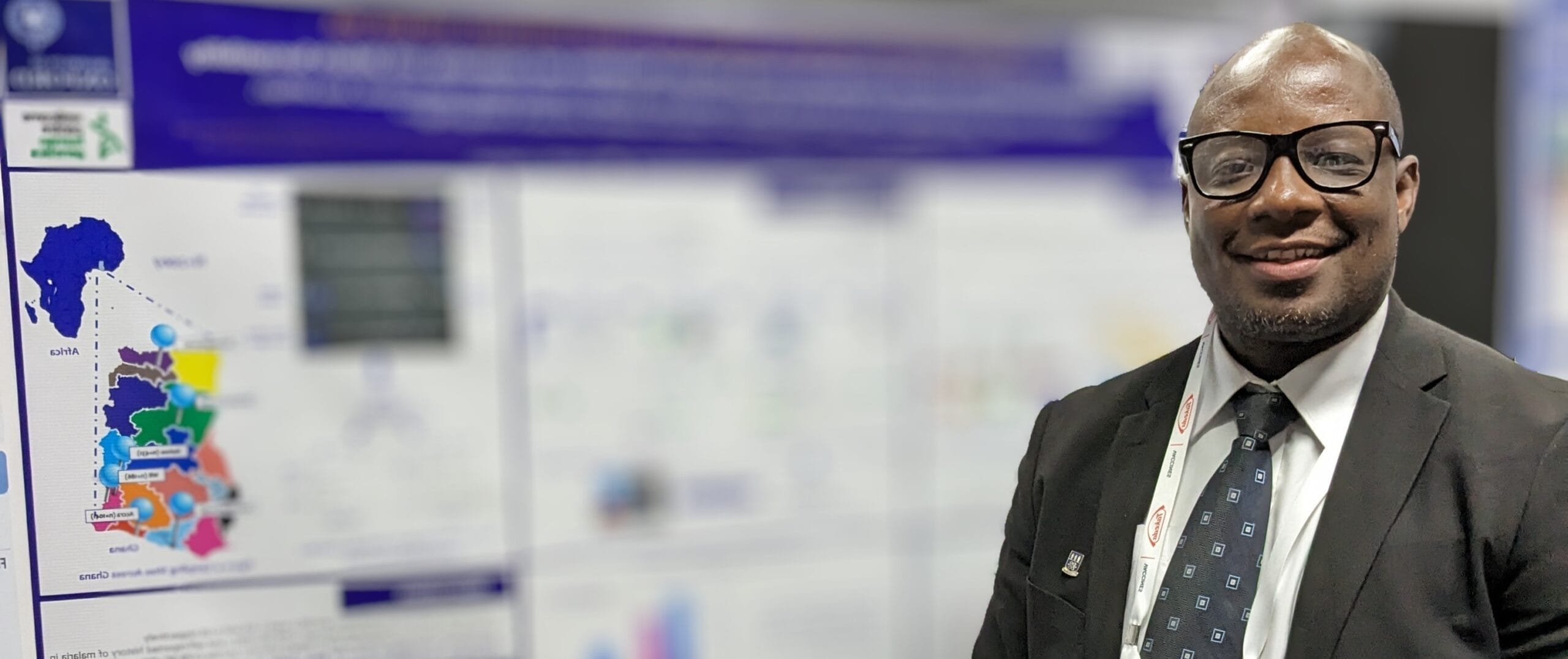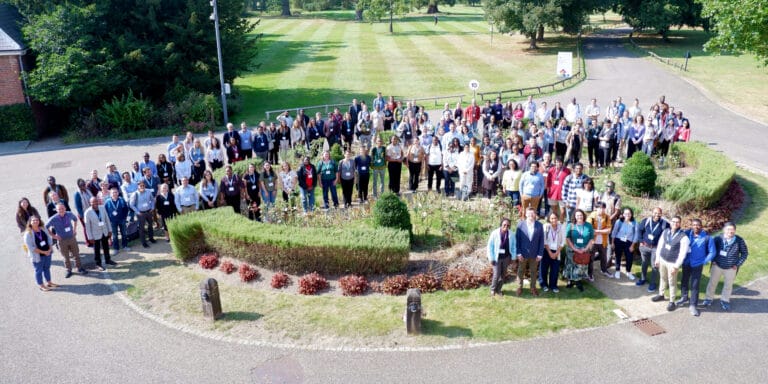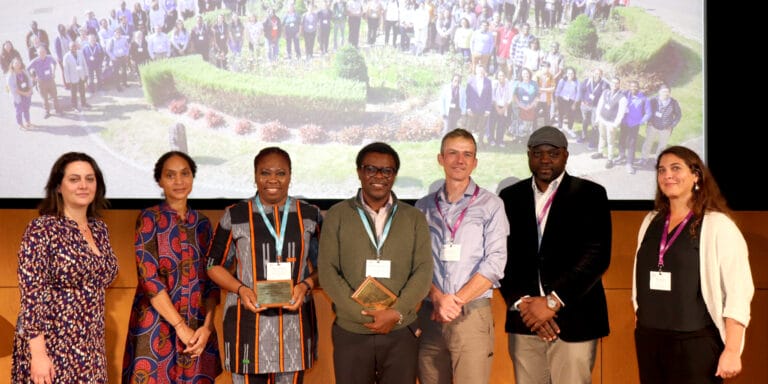Dr Dominic S. Y. Amuzu always has a useful analogy to hand; which is helpful when describing complicated concepts in the genomics of human hosts and malaria parasites.
“For most pathogens to enter a human host, they need proteins that are called receptors. These receptors act like receptionists, they receive a ‘guest’ into the host cell, tissue, or organ.”
This fundamental bit of biology underpins the last six years of Dominic’s research, which has focused on one group of receptor proteins called glycophorins. The Plasmodium parasites that cause malaria use these receptors, found on the surface of human red blood cells, to invade these cells. This part of the parasite’s complicated life cycle – invading and asexually reproducing within the red blood cells – causes the symptoms of malaria which kill over 600,000 people worldwide, mostly young children in sub-Saharan Africa.
What Dominic has been investigating is how changes in human genes that code the glycophorin proteins can affect whether people develop the severe forms of malaria. Specifically, he has been looking at copy number variations (CNVs), when whole chunks of the DNA sequence in a gene are either duplicated, sometimes several times over, or deleted entirely. He started by investigating how the deletion of the human glycophorin B (GYPB ) gene affects the Plasmodium parasite’s entry into red blood cells and the growth of the parasite.
These sorts of mutations in the human genomes happen all the time. When the variations prove beneficial it gives those individuals a better chance of surviving beyond childhood, meaning the genetic variations stick around in the population. Over time through generations that variation becomes more common. This is all part of the evolutionary arms race between most hosts and pathogens.

In the case of glycophorin receptors, genetic variations can alter their shape or structure and prevent parasites from interacting efficiently with it during the invasion of the red blood cells. In this scenario, only parasites with their own variations that allow them to interact properly with the variant host receptors survive into the next generation, thus forcing the parasites to evolve in turn. Another analogy from Dominic: “If I don’t like you coming to my house, I change the locks. Only those who are able to also modify their keys to fit the modified lock are now able to open the door and enter.” This is how the host and malaria parasite have been co-evolving together over many generations.
Like identical triplets, different but so alike
However, identifying the changes in the human glycophorin genes is no easy task. For starters, there are five different glycophorin proteins all coded for by different genes. Three of these (GYPE, GYPB, and GYPA) are found near each other on the same chromosome. Then there are multiple ways the deletions and duplications can occur within the DNA sequence.
“You have three separate genes that are all so similar,” explains Dominic. “The three receptionists are like identical triplets, different distinct individuals but so much alike. The first problem is that if a section of one gene is missing or has multiple copies, we are unable to tell which of these identical genes is involved.”
That meant Dominic’s first task was to design molecular biology tests that could take a sample from a person and quickly confirm the genotype of the glycophorin genes – whether they had deletions or duplications compared to the original ‘wild type’ glycophorin genes.
He did this by lining up the DNA sequences for the three glycophorin genes on chromosome 4 and looked for subtle differences in the genetic sequences. This allowed him to design assays that amplify the region where the deletions were occuring. Dominic then used restriction enzymes that recognise specific DNA sequences to cut the DNA at these unique parts of the sequence. Depending on the sizes of fragments of the DNA pieces, he could tell which genotype of the GYPB an individual was carrying in their genome.
This new test could now quickly survey many people for glycophorin mutations. It was an important step to investigating how these genetic changes impact the onset of severe malaria.
A very rich genetic diversity

Over the next three years, Dominic took samples from around 3,000 individuals across Ghana. Alongside testing for alterations to their glycophorin genes, he surveyed their malaria infection status and history. He also recorded their ethnic group.
“There is a very rich genetic diversity in Ghana,” explains Dominic, who gathered samples from members of 27 different groups. “If you took only Ashanti or only Ewe people, sampled a thousand of them, you cannot draw conclusions with that for the entire country.”
Indeed, some groups showed a much higher frequency of deletions in their glycophorin genes. Dominic noted that these groups were often traditionally pastoral nomads, moving over vast areas and spending a lot of time in outdoor rural settings. This would expose them more often to malaria parasites and mosquito vectors, encouraging genetic changes to resist the disease over generations.
What happens on the cell surface
Dominic now took his research back into the lab, to understand what was actually happening on the surface of the red blood cells as malaria parasites tried to invade. He observed how gene deletions removing a specific glycophorin protein, GYPB, resulted in an increase in other receptor proteins on the cell surface. The absence of GYPB also slowed the growth of those strains of the parasite which are dependent on sialic acid, a residue of cell-surface glycoproteins to which many pathogens bind in order to aid their infection of cells.
Taken together, a picture is building of how glycophorin gene mutations can hinder the invasion and growth of malaria parasites in blood cells. It doesn’t stop them altogether, since they have other similar receptors to choose from, but it certainly seems to slow things down.
Dominic suggests why this may be: “Even though you like the same type of coffee, there’s probably a particular brand that you like. It’s very likely that, even though you have glycophorin A, B, and C in the system, [certain types of] parasites will prefer to be with glycophorin B.”
All this gives the human immune system a better chance of resisting malaria parasites without causing extreme symptoms. “The changes in the gene allow the parasitaemia [level of parasites in the blood] to grow only slowly. So the immune cells know they are there and can be active. But the numbers can not be too much to give you cerebral or full-blown malaria.”

A voice for young African scientists
Having completed his PhD in Ghana at the West African Centre for Cell Biology of Infectious Pathogens (WACCBIP), Dominic is currently based at MRC Unit The Gambia, part of the London School of Hygiene and Tropical Medicine (LSHTM). Here he will continue his research as part of the PAMGEN project, further screening populations in multiple African countries for glycophorin gene deletions and more.
Dominic is an enthusiastic advocate for scientific collaboration across Africa, particularly support for scientists early in their careers. He has started a small mentorship foundation and ultimately hopes to roll out scholarships for young researchers.
He is also involved in a nascent network of early-career African scientists, which aims to support mentorship opportunities, collaboration, grant writing, sampling, and other knowledge sharing. “This movement will give us a voice as young scientists in Africa, in order to tell the world what we need for our development. It will enable us to determine the challenges affecting young scientists in Africa.”
“With all the genomic data that we have, what is the next big phase? That is what I am exploring now – the big goal, the big ideas that will actually impact the future. But I don’t intend to do this alone, which is why I want to build our capacity in Africa.”



